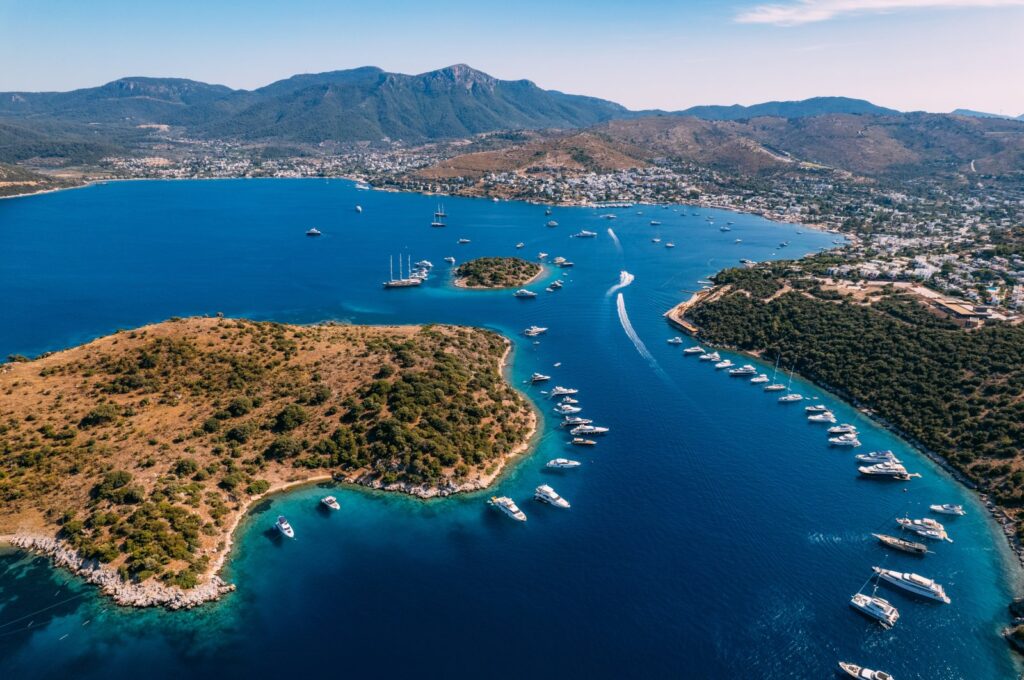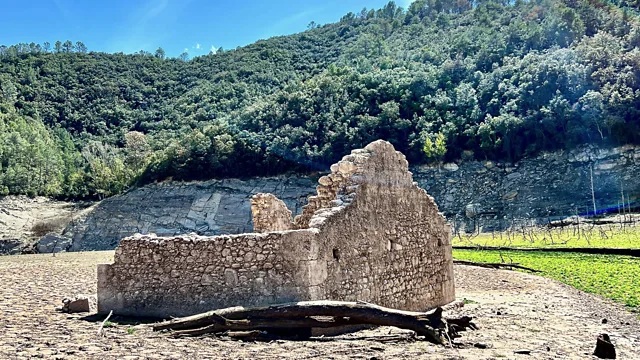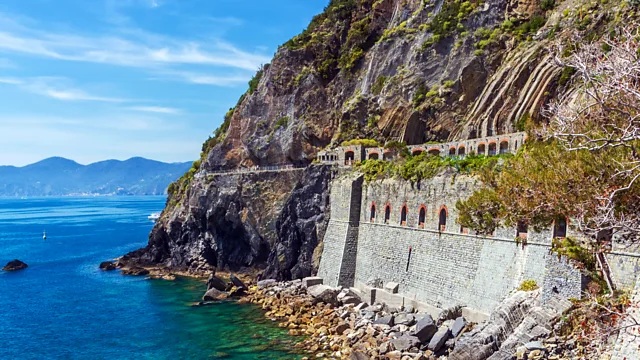
Daniel Stables
Amid the mist-cloaked, forested slopes of the Dyfi Valley, outside the Welsh market town of Machynlleth, is a remarkable sight: a seemingly ramshackle collection of log cabins, old wind turbines, thatched huts, steel tubes and funicular railways, rising from the banks of a former slate quarry. It looks at once incongruous and perfectly at home; both organic and man-made, as if it had grown there like a strange bionic jungle from the seeds of industry long abandoned. Perhaps that’s appropriate, given that the Centre for Alternative Technology (CAT) has spent the last half a century redefining the relationship between nature and humankind.
As it prepares to celebrate its 50th birthday in 2023, its work has never been so urgent.
CAT was founded in 1973 by an eclectic, experimental community of architects, engineers, builders and organic growers, led by businessman and environmentalist Gerard Morgan-Grenville. They felt compelled to seek alternative ways of living in response to an international oil crisis, ignited by the Yom Kippur War in Israel, that saw governments across Europe ban driving on Sundays and impose rations on heating. In 1975, a visitor centre was opened to increase public awareness and engagement, setting the tone for CAT’s unique identity: part research centre, part tourist attraction and part educational hub.
Today, the centre offers master’s degrees in fields such as green building, energy provision and sustainable food; many CAT alumni have gone on to be leaders in the sustainability field, such as architect Kirsty Cassels, voted Social Entrepreneur of the Year at 2019’s Scottish Women’s Awards, and solicitor Sonya Bedford, awarded an MBE for her contributions to community energy. The centre is marking its half-century milestone by embarking on an ambitious redevelopment project, modernising and scaling up both its visitor experience and educational offerings, while remaining open to the public. Visitors can get hands-on with workshops in sustainable building materials, woodland management, organic gardening and more; children particularly love the wildlife activities, such as pond-dipping, monitoring nest cams and laying moth traps.
I was met at reception by Rob Bullen, CAT’s marketing manager, and Eileen Kinsman, interim co-CEO. We climbed aboard the funicular railway – one of the steepest in the world, with a gradient of 35 degrees. As a tank at the top filled with water, one at the bottom was emptied; gravity did the rest, and we were pulled up a sheer cliff with hydropower.

As a tank at the top of the funicular railway filled with water, one at the bottom was emptied; gravity did the rest (Credit: Centre for Alternative Technology)
Such innovation is everywhere at CAT. I was shown rooms full of heat pumps and clanking biomass boilers; thick-walled, small-windowed homes built in the 1970s as models for sustainability; and a modern lecture hall with walls made of rammed earth, a lower-carbon alternative to concrete (the production of cement, a key ingredient in concrete, contributes to approximately 7% of all greenhouse gas emissions worldwide). Small buildings pepper the grounds as standalone experiments, among them the “Hairy Hut”, made from layered thatch and resembling Cousin Itt from the Addams Family.
“One of the most amazing things about CAT is the transformation of the slate quarry,” said Kinsman. “What was a brownfield site has been transformed into productive organic vegetable gardens and a wildlife haven.” Pine martens, otters and dormice are among the animals that have returned. Young woodland smothers the floor of the former mining pit, with scattered pieces of rusting, skeletal hardware the only clues as to the quarry’s former life. “It’s like the Lost World down there,” said Bullen.
A bevy of green businesses have emerged as offshoots of CAT. Many innovations begin life as projects of CAT master’s students; for example, the company Adaptavate, which creates carbon-negative plaster and plasterboard, grew out of founder Tom Robinson’s experiments while studying here.
Pointing out an unassuming-looking wooden shed, Kinsman said: “That hut spun out a number of businesses, including Dulas [a renewable technology company]. That’s where their solar-powered fridge was invented; nearly half Dulas’ business now is solar-powered vaccine fridges.”
It’s hard to imagine a more vivid illustration of how CAT’s innovations, once viewed as wacky by outsiders, have assumed crucial importance in the modern world, even to the point of rendering the centre’s name somewhat obsolete. “These technologies aren’t alternative anymore,” Bullen said. “They’re mainstream.”

CAT is a seemingly ramshackle collection of log cabins, old wind turbines, thatched huts, steel tubes and funicular railways (Credit: Centre for Alternative Technology)
When the first pioneers moved to CAT in the 1970s, their concerns, and those of the wider environmentalist movement, centred on limits to Earth’s resources; by the 1990s and 2000s, the hole in the ozone layer and climate change had come to predominate. Since 2007, the emphasis has been on carbon, with CAT leading the charge to take Britain to net zero by 2040.
“In response to the global climate crisis, sustainable solutions developed by CAT will hopefully help Wales and the UK achieve net-zero greenhouse gas emissions by the middle of this century,” said Val Hawkins, chief executive of MWT Cymru tourism organisation.
Machynlleth has transformed in the decades since CAT’s opening, turning from ancient market town into a haven for eco awareness. This is partly through the centre’s creation of green businesses, which comprise a significant part of the local economy, but also through various other eco initiatives in the area. In 1977, the Unesco Dyfi Biosphere Reserve, which encompasses Machynlleth and the surrounding Dyfi Valley, was established to protect the region’s peat moorlands, sand dunes, beaches and woodland. Together, these habitats are home to red kites, dolphins and water buffalo, while nesting ospreys can be seen at the nearby Dyfi Wildlife Centre, which re-opened in spring 2022 with a state-of-the-art, carbon-positive visitor building.

Machynlleth has transformed in the decades since CAT’s opening, turning from ancient market town into a haven for eco awareness (Credit: Getty Images)
Machynlleth’s eco credentials have attracted luminaries who tie in with the area’s longstanding reputation for alternative thinking, bohemianism and the arts. One erstwhile resident is the activist George Monbiot: Guardian columnist, author of the bestselling rewilding book Feral and perhaps the most recognisable face in British environmentalism. Other famous faces have included Robert Plant and Jimmy Page, who wrote much Led Zeppelin material in a nearby cottage; while Y Tabernacl theatre and the Museum of Modern Art are both acclaimed spaces dedicated to supporting local arts and promoting Welsh and Celtic culture.
Many obituaries have been written for the British high street in recent years. Not so Machynlleth, whose handsome main thoroughfare counts among its mainstays an organic foods shop, a natural health centre and an Ayurvedic chocolatier and apothecary. I turned from the window of the latter, advertising ashwagandha powder and triphala remedies, to see a man in a rainbow poncho, carrying a wizard’s staff, walk into a branch of swanky paint merchants Farrow & Ball. It’s an image that sums up at least one facet of modern Machynlleth: an air of well-heeled bohemianism, shared with the likes of Glastonbury and East Grinstead across the border in England.
I wondered how the influx of well-meaning settlers had gone down in this traditional, Welsh-speaking, farming town. “In the ’70s there were individuals who didn’t like CAT, because they saw it as something from the outside – but that’s very much a minority sport now,” said Andy Rowland, managing director of local sustainability organisation Ecodyfi. The incomers have long since integrated with the local community, with many of their children attending Welsh-speaking schools; and besides, their principles align closely with those that are deep-rooted in Welsh culture.
“The respect for stewarding the land is inherent in Welsh society and culture,” said Rowland (Credit: Centre for Alternative Technology)
There is a Welsh noun, cynefin, that is sometimes translated into English as “habitat”, but really means something much deeper, evoking the weight of time and the power of connection to a place. It was originally a farming term, used to describe the tracks which animals wore into their hillsides and valleys, and to which they would habitually return, generation after generation.
“The respect for stewarding the land is inherent in Welsh society and culture,” said Rowland. “I’m very pleased about the suite of Welsh government policies. The Well-being of Future Generations Act is recognised worldwide as a leader. In the rest of the UK, there’s a difference in emphasis. The language in England is about ‘natural capital’ and ‘environmental assets’ – economic terms. We don’t tend to use that language in Wales.”
Even so, economic motivations, particularly tourism, have a role to play in preserving the area’s precious landscapes. In addition to CAT’s visitor activities and osprey-viewing at the Dyfi Wildlife Centre, there are magnificently picturesque places to stay, such as Cefn Coch Farm, where ecology workshops and nature walks through Cambrian wildwood are on the agenda. These things all contribute to a wider understanding that the concerns that fuelled innovation at places like CAT are no longer fringe fears but matters of urgency.
“People understand now that the future really does involve these technologies,” Rowland said. “They’re not weird. They’re not wacky.”
Courtesy: BBC
The post The UK’s haven for alternative thinking appeared first on The Frontier Post.








